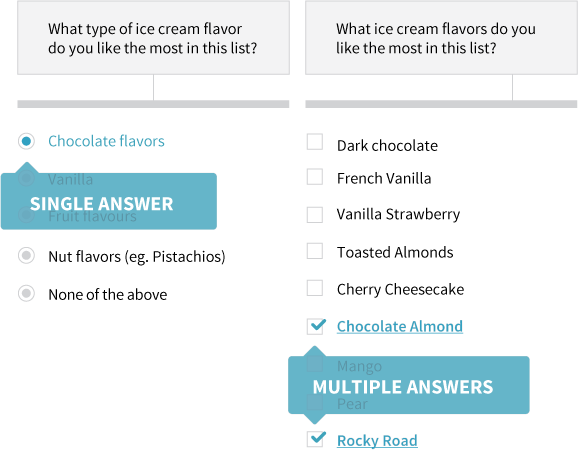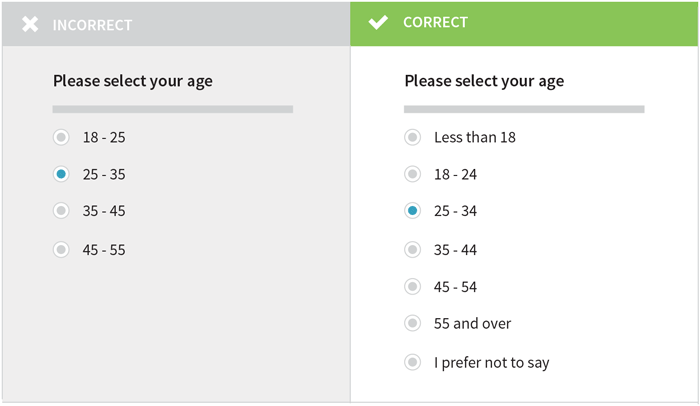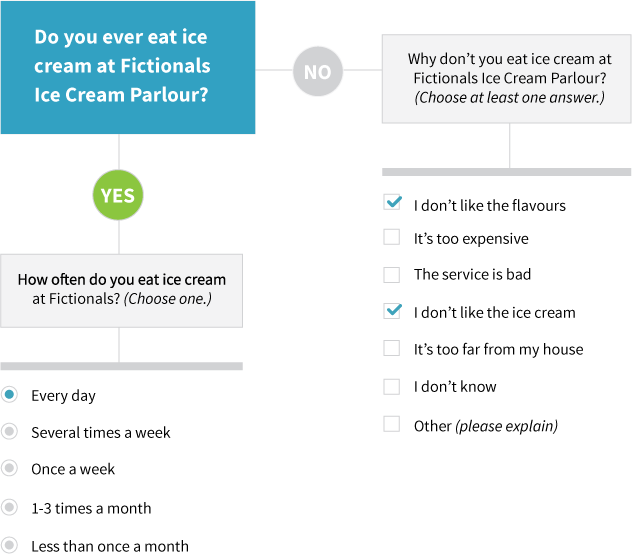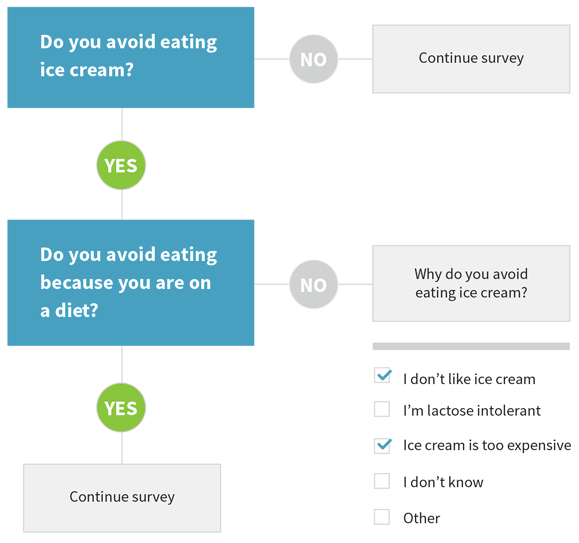
Chapter 4
第四章
Types of Survey Questions
调查问卷问题类型
By Ginette Law
原作者:Ginette Law
After you’ve decided what type of survey you’re going to use, you need to figure out what kinds of questions to include. The type of question determines what level of data can be collected, which in turn affects what you can do with the data later on. For example, if you ask about age and you record it as a number (e.g., 21, 34, 42), you’ll have numeric data that you can perform mathematical operations on. If you instead ask for a person’s age group (e.g., 18-24, 25-34, 35-44), you’ll have ordered categorical data: you’ll be able to count how many people were in each group, but you won’t be able to find the mean age of your respondents. Before you create your survey, it’s important to consider how you want to analyze your final results so you can pick question types that will give you the right kind of data for those analyses.
当你决定好准备用哪种调查问卷类型之后,你需要搞清要包含哪些问题类型。问题的类型决定了能够被收集到的数据的层次,反过来会影响你之后能对这些数据做些什么。举个例子,如果你问有关年龄的问题,并且你用数字来记录它们(如21,34,42等),你将会得到数值型的数据,你可以在这些数据上做数学操作。如果你改为问一个人的年龄层(如18-24,25-34,35-44等)那你得到的是有序分类数据:你可以数出每个年龄层有多少人,但你没法得到调查对象的平均年龄。在你创建调查问卷之前,考虑好你要如何分析最后的结果是很重要的,这样你选出的问题类型才能带给你适合这些分析的数据。
Open vs. Closed Questions
开放式问题 vs. 封闭式问题
Open (or open-ended) questions are used when you want to collect long-form qualitative data. You ask the person a question without offering any specific answers from which to choose. This is often a good option to discover new ideas you may have overlooked or did not know existed. In a closed question, however, a limited number of specific responses are offered to answer the question. Closed questions are used when you already have an idea what categories your answers will fall into or you’re only interested in the frequency of particular answers.
当你想搜集长的、定性的数据的时候应当使用开放 (或开放式) 问题。问别人问题的时候不提供任何特定的,可以从中选择的答案。这是一个帮助你发现你忽略了的或者不知道的新点子的好选择。然而,在封闭式问题中,回答问题时要从有限的特定回复之中选择。当你已经知道答案的类别或者当你只对某些答案的频率感兴趣时应当使用封闭式问题。
Let’s pretend you work for an ice cream parlour called Fictionals. You want to know why some people don’t come to your store. Here are open and closed questions you could ask to find out their reasons.
假设你给一个叫做Fictionals的冰淇淋店工作。你想知道为什么有些人不来你的店。这是一些你让你找出他们不来的原因的可以问的开放式及封闭式问题。

In the closed question, you offer the most probable reasons why people would not go eat ice cream at your store, whereas in the open question, you just ask why they don’t eat at Fictionals and allow respondents to answer however they want.
在这个封闭式问题(图中左栏)中,你给出了人们为何不来你的店吃冰激凌的几种最可能的原因。然而在那个开放式问题(图中右栏)中,你仅仅问了他们为何不在Fictionals吃冰激凌并且允许调查对象想回答什么就回答什么。
When you ask an open-ended question you gain new insight to why some people might not try your ice cream: it’s not because they don’t like ice cream or they don’t like Fictionals, it’s because they can’t eat it! With this new insight, you could choose to offer a new type of ice cream and attract a clientele you didn’t appeal to before.
当你问开放式问题的时候你能就为何人们不吃你家的冰激凌的原因得到新的认识:并不是因为他们不喜欢冰激凌或者不喜欢你们的Fictionals冰激凌店,而是因为他们不能吃冰激凌!有了这个新认知,你可以选择提供能够吸引以前吸引不来的客户群的新型冰激凌。
This is a distinct advantage of open-ended questions, and it’s particularly useful if you’re doing exploratory research and will primarily be reading through the responses to get a sense of how people responded. However, it takes considerably more work to analyze and summarize these data.
这是开放式问题的突出优点,并且当你在做探索性研究并且主要是通过阅读答复来了解人们是如何回答的时候,这是非常有用的。然而,为了分析和总结这些数据,开放式问题比封闭式问题要多花相当多的功夫。
When you think that most people will give more or less the same answer, you can combine an open and closed question to get the best results. This is usually done by offering a number of predefined choices, but leaving room for participants to explain their response if it falls under the “Other” category. Here is how the same question would look if you transformed it into a combined open and closed question:
当你认为大多数人都会给出差不多一样的答案时,你可以将开放式和封闭式问题结合起来以期得到最好的结果。通常做法是:提供几个预先设定好的选项,同时如果答案是“其他”则留下空白处让参与者解释自己的回答。上面同一个问题如果转变成开放和封闭结合式问题就长这样:

Closed Question Types
封闭式问题
Multiple Choice Questions
多选题
Sometimes you’ll want the respondent to select only one of several answers. If your survey is online, you use radio buttons (or circles), which indicate to choose just one item. If you want to allow the respondent to choose more than one option, you should use a checkbox instead. Here is what it looks like in practice:
有时你希望调查对象从多个答案中只选择一个。如果你的调查问卷是在线式的,你可以用单选按钮(或圆圈)来表明只选择一个选项。如果你想允许调查对象选择不止一个选项,你应该用复选框。下面是实际操作中的样子:

If your survey is a paper or administered survey, you would use printed or verbal directions to indicate how many options the respondent should pick (e.g., “Please choose one”; “Please select up to 3”; “Please select all that apply”).
如果你的调查问卷是纸质问卷或者是代填式问卷,你应该在纸上写明或者口头指明调查对象应该选几个选项(如“请选择一个”,“请最多选择3个”,“请选择所有符合条件的”)。
Answer choices should not overlap and should cover all possible options. This is called having “mutually exclusive and exhaustive” categories and is crucial for sound survey design. Consider the situation below:
答案选项不应该有重叠的部分,同时应该覆盖所有可能的选择。这叫做拥有“互斥并且穷尽的”类别,这对设计全面的调查问卷来说是至关重要的。

In the left set of choices, someone who is 25 wouldn’t know whether to select the 18-25 button or the 25-35 button, and someone who is 60 wouldn’t have any option to select at all! The set of age categories on the right is better because it includes all possible age groups, the age choices don’t overlap, and it allows people the choice to withhold that information if they choose to.
左侧的选项中,一个25岁的人没法知道自己该选18-25那个按钮还是25-35那个按钮,一个60岁的人则根本没选项可以选!右边的年龄组别集合要好一些因为它包含了所有可能的年龄组,年龄选项互不重叠,同时允许调查对象选择不提供这个信息。
It is advisable to include a “Prefer not to answer” option for questions that may be of a personal nature, such as race, ethnicity, income, political affiliation, etc. Without this option, people may skip the question altogether, but you won’t be able to tell later on who skipped the question on purpose and who missed it accidentally, which can be an important difference when you analyze your data.
对于和个人信息比如人种、种族、收入、政治关系等有关的问题,包含一个“我不想回答”的选项是明智的。如果没有这个选项,人们可能直接跳过这个问题,但是你就没法知道谁是故意跳过的而谁是不小心忘了回答的,这在你分析数据的时候可能是个重要的区别。
It won’t always be practical to list every possible option. In that case, including “None of the above” or “Other” choices may be helpful. This makes it less likely that people will just skip the question and leave you with missing data. You may also consider including a “Not Applicable” (i.e., “N/A”) choice for questions that may not apply to all of your respondents, or a “Don’t know” choice for questions where a respondent may not not have the information available.
列出所有可能的选项并不总是可行的。如果这样的话,把“以上都不是”,或者“其他”这样的选项加入进去也许有帮助。这样的话,人们跳过这个问题给你带来缺失数据的概率会降低一些。对一些也许不是所有调查对象都适用的问题你可以考虑加入一个“不适用” (也就是, “N/A”)的选项。或者给一些调查对象目前缺少信息来回答的问题加上“我不知道”的选项。
Dichotomous Questions
两项式问题
Dichotomous questions are a specific type of multiple choice question used when there are only two possible answers to a question. Here are some classic examples of dichotomous type questions:
两项式问题是选择题中一种特殊情况,一道题只有两种可能的回答。下面是一些两项式问题的经典例子:

You can use dichotomous questions to determine if a respondent is suited to respond to the next question. This is called a filter or contingency question. Filters can quickly become complex, so try not to use more than two or three filter questions in a row. Here’s an example of the logic behind a filter question:
你可以利用两项式问题来决定一个调查对象是否适合回答下一道问题。这成为过滤或者是可行性问题。过滤器可以很快地变得很复杂,所以试着别连续用超过两到三的的过滤问题。下面是个过滤问题背后逻辑的例子:

In an online survey or administered survey, answering “Yes” to the question “Do you ever eat ice cream at Fictionals Ice Cream Parlour?” would take a respondent to the question about how often they do, while selecting “No” would open the checkbox response question asking why they don’t eat there. In a paper survey, all questions would need to be listed on the page and couldn’t be presented conditionally based on a specific response. You could use a flowchart form like in the diagram above, or you could employ skip directions, as illustrated below.
在在线式问卷或者是代填式问卷中,对“你是否曾在Fictionals冰激凌店吃过冰激凌”这个问题回答“是”,则下一题就是他们多久来吃一次;而如果他们选择“不是”则下一题是个问他们为何不在那吃冰激凌的多选题。在纸质问卷中,所有问题都被列在了纸上而并不能根据特定的回答来按照条件展示。你可以用像上图那样的流程图,或者你可以用像下图那种跳跃式指示。

Scaled Questions
量表式问题
Scaled questions are used to measure people’s attitudes, opinions, lifestyles and environments. There are many different types but the most commonly used are Likert and slider scales. The main difference between the two is that a Likert scale consists of ordered categories whereas a slider scale allows respondents to make a mark indicating their response anywhere along a scale. As a result, a Likert scale-type question will give you data that are measured at an ordinal level while a slider scale will give you data that are measured at an interval level.
等量表式问题是用来衡量人们的态度、观点、生活方式和环境的。它的种类有许多,但最常用的是李克特(Likert)式量表和滑块式量表。这二者最大的区别是李克特式包含有序的类别而滑块式允许调查对象在尺上任何地方标记他们的回答。因此,李克特式量表问题给出的是有序的数据而滑块式得出的是按区间划分的数据。

In the example above, the same question is asked twice, once with a Likert scale and once with a sliding scale. Notice that in the Likert scale there are five categories. Scales with an odd number of categories allow participants to agree, disagree, or indicate their neutrality; scales with an even number of categories only allow participants to agree or disagree. If you want to allow for neutrality, scales with an odd number of categories are usually preferred; however, you should use an even number if you want to require the respondent to choose one direction or the other. This is called a “forced question.”
在上面的例子中,同一个问题用李克特式和滑块式分别问了一次。注意在上面的李克特式量表中有5个类别。包含奇数个类别的量表允许回答者表达同意、不同意或是中立;包含偶数个类别的量表只允许回答者表示同意或者不同意。如果你想要允许他们表达中立,通常包含技术个类别的量表是首选;然而,如果你想让回答者只选择一边,就应该提供偶数个选项。这种也称作“强制性问题”。
Likert Scale
李克特式量表
Likert scales are usually limited to a five-category scale, as it is often difficult to clearly display a larger number of categories. The most common Likert scales you will find are:
李克特式量表通常最多有五个类别,因为通常来讲如果类别太多则难以清晰地展示出来。最常用的李克特式量表有:
- Opinions and attitudes: “How much do you agree with…?”
Possible answers: strongly agree, agree, neither agree or disagree, disagree, strongly disagree - Frequency: “How often do you…?”
Possible answers: always, often, sometimes, rarely, never - Quality: “In general, how do you rate the quality of…?”
Possible answers: excellent, very good, good, fair, poor - Importance: “How important would you say {topic} is…”
Possible answers: very important, important, somewhat important, not at all important
- 观点和态度: 你有多同意?
可能的回答:强烈同意,同意,既不同意也不反对,反对,强烈反对 - 频率: 你多久一次?
可能的回答:总是,经常,有时,很少,从不 - 质量: 总体来讲,你认为这个的质量是?
可能的回答:棒极了,很好,好,还行,差 - 重要程度: 你认为这个{话题}有多重要
可能的回答:相当重要,重要,在某种程度上重要,一点都不重要
Slider Scale
滑块式量表
Slider scales are useful when you want to have a more precise reading of a respondent’s views. These scales are most easily implemented in an online survey, since the computer will calculate the position of the marker; when used on a paper survey, you will need to have someone measure the marker’s location on the scale manually. Slider scales may be more practical than Likert scales when conducting a survey that is being translated into multiple languages since text categories are not always easy to translate.
当你想要更精确地解读调查对象的观点的时候,滑块式量表就有用了。在在线式问卷中这些量表大都很容易实现,因为电脑会自动计算标记的位置;如果在纸质问卷中使用,你需要找人手动在量表中测量标记的位置。当一个调查问卷会被翻译成多种语言的时候,使用滑块式量表比用李克特式量表更实用,因为文字的类别并不总是很容易翻译的。

When creating a scale, whether Likert or slider, never forget to label the first and last points in your scale. Otherwise, your respondents may misinterpret your scale and give you inaccurate or misleading data.
无论是创建李克特式量表还是滑块式量表,不要忘了给量表的头尾写上标签。不然的话,你的调查对象很可能错误地理解量表,因而带来不准确的或是误导人的数据。
Question Wording
问题的措辞
It’s extremely important to think about how you word your questions when developing a survey. Here are a few key things to keep in mind:
在创建调查问卷时,思考对问题如何遣词造句是极其重要的。下面是一些需要记住的重要事项:
Focus
关注点
Each question should be specific and have a defined focus.
每个问题都应该具体并且有明确的关注点。
How many times have you eaten ice cream in the last month?
上个月你吃过几次冰激凌?
This question focuses on one issue (frequency of ice cream eating) and is specific (a certain time period).
这道题只关注一个问题(吃冰激凌的频率)并且它是具体的(在某个时间段内)。
Do you avoid eating ice cream because you are on a diet? [Answer: Yes, I avoid ice cream, but not because I am on a diet]
你不吃冰激凌是因为你正在节食么?【回答:是的,我不吃冰激凌,但并不因为我正在节食】
This question is poorly worded for a few reasons: it is both leading and too specific. It assumes that the respondent is in fact on a diet and that this is why he or she doesn’t eat ice cream. A better wording would be “Why do you avoid eating ice cream?” with “I’m dieting” as one of a number of options that the participant can choose from.
这个问题的措辞很糟糕,原因有以下几点:它有诱导性同时过于具体了。它假设回答者实际上在节食,而这就是他/她不吃冰激凌的原因。更好一些的问法应该是“你为何不吃冰激凌?” 并且把“我正在节食”作为参与者可选的一个选项。
You should also avoid using the word “and” if it is connecting two different ideas within a single question. Remember, each question should focus on only one issue at a time: otherwise, you won’t be collecting the best data that you can. By compounding multiple thoughts into a single question, you reduce the accuracy of participants’ responses and thereby limit the claims that you can make from those data. Instead, consider using filter questions to obtain the desired information. For example:
同时你应当避免在同一个问题中用“和”这个词来连接两个不同的想法。记住,每个问题一次都应该只关注一件事情。不然的话,你得到的就不是最好的数据。把不同的思想合并在一个问题里的话,你就降低了参与者回答的准确度,因此限制了你可以从这些数据中能够做出的声明。相反地,考虑使用过滤问题来得到想要的信息。例如:

Precision
准确度
Not everyone will interpret all words and phrasings in the same way, even if the meaning seems obvious to you. To reduce the chance of participants misinterpreting your question, you can parenthetically define ambiguous terms or give additional context as appropriate. Try also to avoid confusing wordings, such as those that use double negatives or many subordinate clauses. Be careful to also not use words that are loaded or have many highly-emotional connotations.
即便句子的意思对你来说显而易见,人们对它的理解可能各有不同。为了减少参与者误解问题的可能性,你可以附带着给有歧义的词下定义,或者根据情况给出另外的上下文。同时试着避免使用容易让人迷惑的遣词造句,比如双重否定句或者有太多从句的句子。还要小心避免使用包含太多高度情绪化含义的词。
| Do | Don’t |
|---|---|
|
|
| 可以做 | 不要做 |
|---|---|
|
|
Brevity
简洁
Your questions should be relatively short, except where additional wording is absolutely necessary to provide context or to clarify terminology. Long, complex questions can quickly become confusing to participants and increase the chances that they will respond without fully understanding what is being asked, or worse, skip the question entirely! If your question seems to be getting too long, consider whether there is any unnecessary information that you can take out or if you can split it up into several smaller questions. Alternately, you may want to have a short paragraph of explanatory text that is separate from the question itself: that way participants will have all necessary background information, but can also easily pick out and digest what is actually being asked.
除了解释必要的上下文或是专业术语时,你的问题应该相对简短。长而复杂的问题会很快让参与者觉得困惑并且增加他们并不理解题意时就回答的概率,甚至更糟,他们会彻底跳过这个问题!如果问题变得很长,考虑是否能从中删去不必要的信息,或你是否能把它拆分成几个小的问题。另外一种方法是,你可以在题之外加一小段解释性的文字。这样的话参与者能得到必要的背景信息同时也能很容易地挑选出并理解问的问题究竟是什么。
| Do | Don’t |
|---|---|
| Please list your three favorite ice creams in order of preference. | Can you please tell us what ice cream flavors you like and what are your first, second, and third favorites? |
| 可以做 | 不要做 |
|---|---|
| 请根据自己喜好程度列出三种你最喜欢的冰激凌口味。 | 请你告诉我们你喜欢的冰淇淋口味,并且写出最喜欢的,第二喜欢的和第三喜欢的味道分别是什么? |
Biased and Leading Questions
偏倚及诱导性问题
Biased or leading questions can easily skew your answers if you do not pay close attention to your wordings. Avoid over-emphasizing your statements and keep an eye out for questions that create “social desirability effects” where respondents may be more likely to answer according to what society views as proper or socially or morally acceptable.
如果你不密切关注遣词造句的话,偏倚的或诱导性问题能轻易地歪曲你收到的答案。避免过度强调你的声明,并且留心造成“社会赞许反应”的问题。这些问题中,回答者也许更倾向于给出从社会观点看来是适当的或是道德上可接受的答案。
| Do | Don’t |
|---|---|
| Do you agree that ice cream vendors in our city should offer peanut-free products? | Do you agree that ice cream vendors that serve peanuts are a severe hazard for the well-being of our children? |
| 可以做 | 不要做 |
|---|---|
| 你同意本市的冰激凌店应提供不含花生的产品么? | 你是否认同贩卖含花生的产品的冰激凌店对孩子们来说是个严重的危害? |
Notice how the second question tries to bias the respondent by using strong or affective phrases such as “severe hazard.” You should try to keep your questions as value-free as you can: if the question itself suggests how the participant is expected to answer, it should be reworded.
注意看第二个问题是如何通过利用强烈的、有感情的词如“严重的危害”来影响回答者的。你应该尽最大努力保持问题价值观中立。如果问题本身就影射出了你希望参与者给出什么样的回答的话,这个句子应该被改写。
A Few Final Things…
最后几点…
There are few final things to consider when developing your survey questions:
在开发调查问卷的问题是还有最后一点需要考虑:
- If possible, consider varying the type of questions you use to keep your respondents engaged throughout the survey. You have a variety of question types to choose from, so mix it up where you can! (But do keep in mind that each type of question has a specific purpose and gives you more or less specific data.)
- Think about how certain words can have different interpretations and remember that meanings are often embedded in culture and language. Be sensitive to different cultures if you are examining several groups within a population.
- 如果可能的话,考虑通过把问题变得多样化来在整个调查过程中保持回答者的注意力。你有很多不同的问题类型可以选,所以能混搭的时候就混搭把!(但请记住每种问题都有特定的目的并且不同类型会给你更具体的或者更模糊的数据。)
- 思考某些词是能有不同的理解的,并且记住意义通常是牢牢嵌入在文化和语言中的。如果你要调查人群中不同的群体,要对不同文化有敏感度。
Designing Your Questionnaire
问卷设计
Once you have identified the purpose of your survey and chosen which type you will use, the next step is to design the questionnaire itself. In this section, we’ll look at the structure, layout and ordering of questions. We’ll also talk about some key things to keep in mind once you’re done.
当你明确了调查问卷的目的并且选择了你要用的类型之后,下一步就是设计问卷本身了。这部分会介绍问卷的结构,布局和问题的顺序。还会聊到一些你完成问卷设计后需要记住的关键点。
Questionnaire Structure
问卷结构
Do you remember when you were taught in grade school that every essay should have an introduction, body and conclusion? Questionnaires should also have a certain structure. The major parts of a questionnaire include the introduction, main topic, transitions between topics, demographic questions, and conclusion.
还记得上小学时老师教你每篇作文都应该有导言、正文和结论么?问卷也应该有某种结构。问卷的主要部分包括引言、主题、主题间的过渡、人口统计问题和结论。
Introduction
引言
Always start your survey with a brief introduction which explains:
在调查问卷的开头永远要用简单的引言来解释:
- the purpose of the survey;
- who is conducting it;
- the voluntary nature of the participant’s involvement;
- the respect for confidentiality; and
- the time required to complete the survey.
- 该问卷调查的目的;
- 是谁在组织这次调查;
- 参与者是自愿参与的;
- 我们尊重保密性;及
- 完成调查问卷的时间限制。
Main Topics
主题
Generally, it is best to start with general questions and then move on to more specific questions.
通常来说,从普遍性问题开始问起,逐渐过渡到更具体的问题是最好的。
- Ask about objective facts before asking more subjective questions.
- Order questions from the most familiar to least.
- Make sure that the answer to one question does not impact how the participant interprets the following question.
- 先问客观事实再问主管问题。
- 问题应该按熟悉程度排序,最熟悉的在最,最不熟悉的在最后。
- 保证一道题的答案不影响参与者对下一道题的理解。
Transitions Between Topics
主题间的过渡
Use transitions between groups of questions to explain a new topic or format. For example: “The next few questions are related to the frequency of your TV viewing habits. Please choose the answer that best describes your situation.”
在题目群之间用过渡来解释新的主题或者格式。比如:“下面几个问题和你看电视的频率有关。请选择最符合你情况的答案。”
Demographic Questions
人口统计问题
Unless you are using demographic questions as filtering criteria for survey eligibility, it is usually better to put them near the end of a survey. Typical demographic questions include:
除非你是用人口统计问题作为过滤标准来检查调查对象是否适合回答这个问卷,通常来说把人口统计问题放在在接近问卷末尾处比较好。典型的人口统计问题有:
- gender;
- age;
- income;
- nationality or geographic location;
- education; and
- race or ethnicity.
- 性别;
- 年龄;
- 收入;
- 国籍或地理位置;
- 受教育程度;及
- 人种或种族。
Conclusion
结论部分
Thank the participants for their contribution and explain how it has been valuable to the project. Reiterate that their identities will be kept confidential and that results will be anonymized. If you wish, you can also include your contact information in case they have any additional questions related to the survey and also ask for their contact information if you are offering an incentive for completing the survey.
表达对参与者贡献的感谢,并且解释这对该项目是如何有价值。重审他们的身份会被保密并且结果会被匿名。如果你愿意的话,你也可以加上你的联系方式以防他们另外还有和调查问卷相关的问题,如果完成调查问卷是有偿的,你也应该询问他们的联系方式。
If you contact respondents in advance to invite them to participate in the survey, you should also explain why they have been selected to participate, when the survey will take place, and how they can access it.
如果你是在提前邀请调查对象参与一个调查,你也应该解释为什么选中他们来参加,调查什么时候开始,以及他们该如何参与。
General Layout
通用布局
There are a few good rules to follow when designing the layout of your survey:
关于调查问卷的布局设计,有几条好习惯应当遵守:
- Put your introduction and conclusion on separate pages from your questions.
- The format should be easy to follow and understand.
- Check that filter questions work as intended.
- Stick to questions that meet your goals rather than just asking every question you can think of. In general, survey completion rates tend to diminish as surveys become longer.
- Leave enough space for respondents to answer open-ended questions.
- Make sure to include all likely answers for closed-ended questions, including an “Other” option in case respondents feel that none of the provided answers suits them. Where appropriate, also include “Not Applicable” and “Choose not to respond” options.
- Ensure that questions flow well and follow a logical progression. Begin the survey with more general questions and then follow with more specific or harder issues. Finish with general demographic topics (e.g., age, gender, etc.), unless you are using these to screen for eligibility at the beginning of the survey. Group questions by theme or topic.
- 把引言和结论放在单独的段落里,不和问题混在一起。
- 形式应该容易被理解。
- 检查过滤问题是否按你想的工作。
- 只保留和你目标一致的问题而不是问所有你能想到的问题。通常来讲,调查问卷的完成率随着问卷长度的增加而减少。
- 留足够的空白让回答者回答开放式问题。
- 确保封闭式问题包含了所有可能的回答,加入一个“其他”选项以防回答者感到所有提供的选项都不符合他们的情况。在合适的地方加上“不适用”及“我不想回答”的选项。
- 确保问题的流动性好并且有合乎逻辑的进展。从普通的问题问起,然后再问更具体或更难的问题。在结尾处问一般的人口普查问题(如年龄、性别等),例外是这些问题被用来筛选调查对象合格性时应放在开头。还应根据话题或主题来把问题分组。
Some Further Considerations
一些进一步的考虑
Consider Your Audience
考虑你的观众
Think about the people who will be participating in your survey. Let’s say, for example, that you want to conduct a survey in a school where many students have recently immigrated to the country as refugees with their families and don’t yet speak the local language well.
想想可能参与你的问卷调查的人。比如假设你想在一个很多学生是最近作为难民随家人移民到这个国家并且本地语言还说不太好的学校进行问卷调查。
In what language(s) should you conduct the survey? Should you only conduct the survey in the local language or instead prepare it in several languages? If you’re preparing different versions of the survey, who will ensure consistency among the translations?
你应该用什么语言或哪几种语言来进行问卷调查?你应该只用本地语言还是说要给问卷准备几种不同的语言?如果你要给问卷准备几种不同的版本,由谁来确保不同版本的一致性?
What kind of vocabulary should you use? These are students who may not be taking the questionnaire in their native language. You will probably want to use fairly basic language, especially if many are not native speakers. We have not specified their age, but it would be useful to take this information into consideration when thinking about vocabulary.
你应该用什么样的词汇?有的学生也许答的问卷不是他们自己母语。你应该大致用比较基础的语言,尤其回答者的母语不是这种语言的时候。我们没指出他们的年龄,但考虑词汇量时注意这部分信息也会有用。
Word Instructions and Questions Clearly and Specifically
清晰明确地表达说明部分和问题
It is important that your instructions and questions are simple and coherent. You want to make sure that everyone understands and interprets the survey in the same way. For example, consider the difference between the following two questions.
说明部分和问题部分简单且清楚是重要的。你想要确保每个人对调查问卷的理解是一致的。比如,思考下面两个问题的区别。
- When did you first notice symptoms? ______________________
- When did you first notice symptoms (e.g., MM/YYYY)? __ __ / __ __ __ __
- 你什么时候第一次发现症状的? ______________________
- 你什么时候第一次发现症状的(如 月月/年年年年)? __ __ / __ __ __ __
If you want the question to be open to interpretation so that people can give answers like, “after I came back from my last trip,” then the first option is okay. However, if you’re really wondering how long each person has been experiencing symptoms, the second version of the question lets the respondent know that you’re interested in the specific time at which the symptoms first occurred.
如果你想让问题有比较开放的解释如人们可以回答说“我上次旅行回来之后”,那么第一种方式是可以的。然而,如果你真正想知道的是每个人有这些症状多久了,那么问题的第二个版本能让回答者知道你感兴趣的是首次发生症状的特定时间。
Pay Attention to Length
注意长度
We often want to collect as much information as possible when conducting a survey. However, extremely long surveys quickly become tedious to answer. Participants get tired or bored which in turn decreases the completion rate. After a while, you risk getting inaccurate responses from people who are trying to finish the survey as rapidly as possible. When reviewing your questionnaire, ask yourself, “Do I really need this question? Will it bring any valuable data that can contribute to my reason for doing this survey?”
当做调查问卷时我们经常希望搜集到的数据越多越好。然而,特别长的调查问卷很快就会让答题人觉得冗长乏味。参与者会变得累或者觉得而反过来减少完成率。过一阵子之后,你就有搜集到那些想尽快完成问卷的那些人的不准确的回答的风险。当审查你的问卷时,问自己“我真的需要这个问题么?它能够得到有价值的数据来对这个调查问卷的背后原因做出贡献么?”
Track Progress
记录进度
It is good to indicate the respondents’ progress as they advance through the survey. It gives them an idea of their progression and encourages them to continue on. In a self-administered survey, a progress bar such as the one below could be placed at the beginning of each new section or transition.
在调查对象答题的进程中,标示出他们的进度是有好处的。这能让他们知道自己的进展并且能鼓励他们继续答下去。在自填式问卷中,像下面这样的进度条可以放在每个新的小节或过度部分。

In an administered survey, the interviewer can simply make statements such as:
在代填式问卷中,访谈员可以简单地用下面这些表述:
- “We are halfway done.”
- “There are only two more sections left.”
- “Only a few more questions to answer.”
- “我们已经完成一半了。”
- “只剩下两部分了。”
- “只剩下几个问题需要回答了。”
Train Interviewers
训练访谈员
If you are conducting an administered survey, you will have to prepare your interviewers ahead of time, explain their tasks, and make sure that they understand all of the questions properly. You may also want them to be supervised when they are first conducting the survey to monitor for quality to control for interviewer effects.
如果你进行的是代填式问卷,你必须提前训练访谈员。给他们解释他们的任务,确保他们正确理解所有的问题。在他们刚开始带领做调查问卷时你也许希望有人监督他们来监控质量、控制访谈员效应。
Pretest
预测试
Pretesting means testing your survey with a few initial respondents before officially going out in the field. This allows you to get feedback to improve issues you might have with length, technical problems, or question ordering and wording. Sometimes this step gets skipped if there’s a tight deadline to meet, but you shouldn’t underestimate its value. It can save a lot of time and money in the end.
预测试是说在正式散发问卷之前先用几个初始的调查对象来测试一下你的调查问卷。你能通过这个得到反馈以改善你可能有的长度方面、技术问题或问题的顺序和措辞方面存在的问题。时间紧时有时这步骤就被跳过了,然而你不应该低估它的价值。到头来它可以节省很多时间和金钱。
Anonymize Responses
将结果匿名化
We briefly mentioned response anonymization earlier when we talked about questionnaire structure. Sometimes, people are afraid to give an honest response for fear that it might be traced back to them. By anonymizing responses you will get more accurate data while protecting the identity of your participants. There are times when you may need to keep respondents’ contact information associated with their responses, like if you’ll be conducting a follow-up survey and will need to know what their initial answers were. Be clear in your survey about whether you’re anonymizing responses or not so respondents know if you’re storing their contact information.
之前在讲问卷结构时我们简要提到了结果匿名化。有时人们不愿给出真实的回答因为怕自己可以被追踪到。通过将结果匿名化你能得到更准确的数据,同时还能保护参与者的身份。有一些情况下你需要把回答者的联系方式和他们的回答联系起来,比如当你需要做跟踪调查时你需要知道他们最初的答案都是什么。在问卷里清楚地写明你是否会将结果匿名化,让回答者就知道你是否会存下他们的调查信息。
You should always anonymize any results you present, whether the data you collect are anonymous or not.
你展示任何结果时都应该是匿名过后的,无论你搜集数据时是匿名的与否。
Incentives
奖品
The use of incentives can be contentious. You want to encourage as many people as possible to participate in your survey, but you also don’t want people completing the survey just to get a reward. Larger reward amounts can also raise ethical concerns of participant coercion (i.e., having individuals participate when they would otherwise refuse due to personal discomfort, risk of repercussions, etc.).
是否利用奖品是有争议的。你想鼓励越多越好的人来参与你的问卷调查,但你不希望人们做问卷调查就是为了得到奖品。高的奖品价值同时还能带来有关强制参与者的道德问题(如,人们会因此而参与他们其他情况下会因如个人不便或可能的不良影响等而拒绝参与的调查)
If the survey is long and time consuming, consider giving a small reward or stipend if a respondent completes the questionnaire. If the survey is shorter, consider doing a prize drawing from respondents who complete the survey and choose to provide their contact information.
如果调查问卷长且需要很多时间来完成,可以考虑给完成的调查对象小奖品或者补偿。如果问卷相对短,可以考虑从完成问卷并且选择提供自己联系方式的调查对象中进行抽奖。
Wrapping Things Up
总结
As you have noticed, there are a number of factors you will need to consider when you’re designing your survey and deciding what types of question to use. Survey creation can seem daunting at first, but remember this is the foundation of your data analysis. Getting this step right will make the rest of your work much easier later on.
相信你已经注意到了,在问卷设计和问题选择上有许多需要考虑的因素。创建问卷刚开始看也许令人望而生畏,但请记住这是你数据分析的基石。把这步做好了,后面的工作会简单得多。
For further reading, please see our resources section.
如果想阅读更多相关信息,请参考相关资源部分.